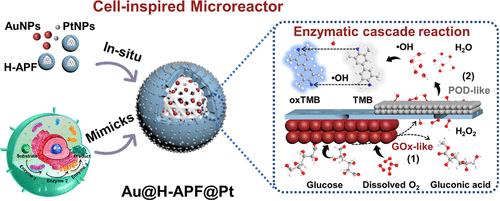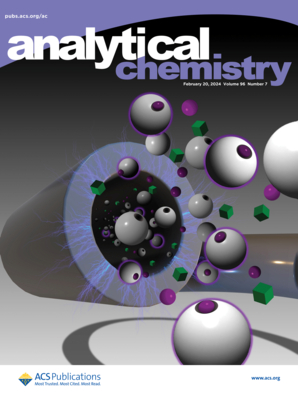Cell-Inspired Microreactor with Compartmentalized Active Sites for Development of Cascade Catalysis System in Biosensing
IF 6.7
1区 化学
Q1 CHEMISTRY, ANALYTICAL
引用次数: 0
Abstract
Enzymatic cascade reactions with high activity and specificity in living cells always benefit from multicompartmentalized organelles that provide separately confined spaces for enzymes, avoiding their mutual interference to ensure the high-efficiency operation of necessary vital movements. Inspired by this, we designed a 3D spherical microreactor (Au@H-APF@Pt) with biomimetic cascade catalysis for glucose detection. First, ultrasmall gold nanoparticles were immobilized in situ on the internal cavities of hollow 3-aminophenol formaldehyde resin (H-APF) nanospheres, along with glucose oxidase activity. Then, platinum nanoparticles (PtNPs) with peroxide-like activity were reduced surrounding the outer layer of the H-APF nanospheres. Similar to the cell structure, different metal sites in this bifunctional microreactor operated independently, bringing higher catalytic activity and selectivity and thus being synergistically capable of a cascade reaction to catalyze the substrate for glucose detection. This cell-mimicking microreactor (Au@H-APF@Pt) was successfully applied in glucose colorimetric detection, showing a 1.9-fold activity enhancement compared to direct mixing (Au/Pt). The observed low catalytic activity was attributed to the extended time for transferring hydrogen peroxide (H2O2) from Au NPs to the solution and then to PtNPs. Integrating a smartphone APP, a real-time, visual, and Au@H-APF@Pt-based hydrogel sensor for glucose detection was also proposed. Satisfactory results highlight that this cell-mimicking microreactor offers a very successful strategy to improve the efficiency of cascade catalysis systems in biosensing.

用于开发生物传感级联催化系统的具有分区活性位点的细胞启发微反应器
活细胞中具有高活性和特异性的酶级联反应总是得益于多室细胞器,这种细胞器为酶提供了单独的密闭空间,避免了酶之间的相互干扰,从而确保必要的生命活动高效运行。受此启发,我们设计了一种用于葡萄糖检测的三维球形微反应器(Au@H-APF@Pt),该反应器具有仿生级联催化作用。首先,超小型金纳米粒子与葡萄糖氧化酶活性一起被原位固定在中空的 3-aminophenol formaldehyde resin (H-APF) 纳米球的内腔中。然后,具有过氧化物活性的铂纳米粒子(PtNPs)被还原到 H-APF 纳米球外层的周围。与细胞结构类似,这种双功能微反应器中的不同金属位点可独立工作,带来更高的催化活性和选择性,从而协同进行级联反应,催化葡萄糖检测底物。这种细胞模拟微反应器(Au@H-APF@Pt)被成功应用于葡萄糖比色检测,与直接混合(Au/Pt)相比,活性提高了 1.9 倍。观察到的低催化活性是由于过氧化氢(H2O2)从金纳米粒子转移到溶液再转移到铂纳米粒子的时间延长了。此外,还提出了一种实时、可视、基于 Au@H-APF@Pt 的水凝胶葡萄糖检测传感器,并将其与智能手机 APP 相结合。令人满意的结果突出表明,这种模拟细胞的微反应器为提高生物传感中级联催化系统的效率提供了一种非常成功的策略。
本文章由计算机程序翻译,如有差异,请以英文原文为准。
求助全文
约1分钟内获得全文
求助全文
来源期刊

Analytical Chemistry
化学-分析化学
CiteScore
12.10
自引率
12.20%
发文量
1949
审稿时长
1.4 months
期刊介绍:
Analytical Chemistry, a peer-reviewed research journal, focuses on disseminating new and original knowledge across all branches of analytical chemistry. Fundamental articles may explore general principles of chemical measurement science and need not directly address existing or potential analytical methodology. They can be entirely theoretical or report experimental results. Contributions may cover various phases of analytical operations, including sampling, bioanalysis, electrochemistry, mass spectrometry, microscale and nanoscale systems, environmental analysis, separations, spectroscopy, chemical reactions and selectivity, instrumentation, imaging, surface analysis, and data processing. Papers discussing known analytical methods should present a significant, original application of the method, a notable improvement, or results on an important analyte.
文献相关原料
公司名称
产品信息
阿拉丁
2,2′-azinobis(3-ethylbenzothiazoline-6-sulfonate) (ABTS)
阿拉丁
poly(acrylic acid) (PAA)
阿拉丁
anhydrous calcium chloride
阿拉丁
sodium alginate
阿拉丁
methylene blue (MB)
阿拉丁
3,3′,5,5′-tetramethylbenzidine (TMB)
阿拉丁
polyvinylpyrrolidone
阿拉丁
ascorbic acid (AA)
阿拉丁
chloroplatinic acid hexahydrate (H2PtCl6·6H2O)
阿拉丁
gold(III) chloride trihydrate (HAuCl4·3H2O)
阿拉丁
ethanol absolute
阿拉丁
aqueous ammonia
阿拉丁
formaldehyde
阿拉丁
3-Aminophenol
 求助内容:
求助内容: 应助结果提醒方式:
应助结果提醒方式:


